Dog training can be a demanding task for both the pet and the owner himself. Not all breeds are obedient from the very beginning. Some breeds tend to be a bit unruly and hard to “tame” when you start the training process. The key is patience and determination.
Corgi dogs are among the perkiest of dog breeds, and sometimes they can have trouble accepting and reacting to training methods. But we can all agree that your dog should not skip on some basic commands. For example, how to train a corgi to come? No matter how simple this may sound, it can take some time.
If you are having difficulties with your corgi’s training and find it hard to teach him some basic command, continue reading this article. We will provide you with different solutions on how to solve this problem and much more critical information about your corgi.
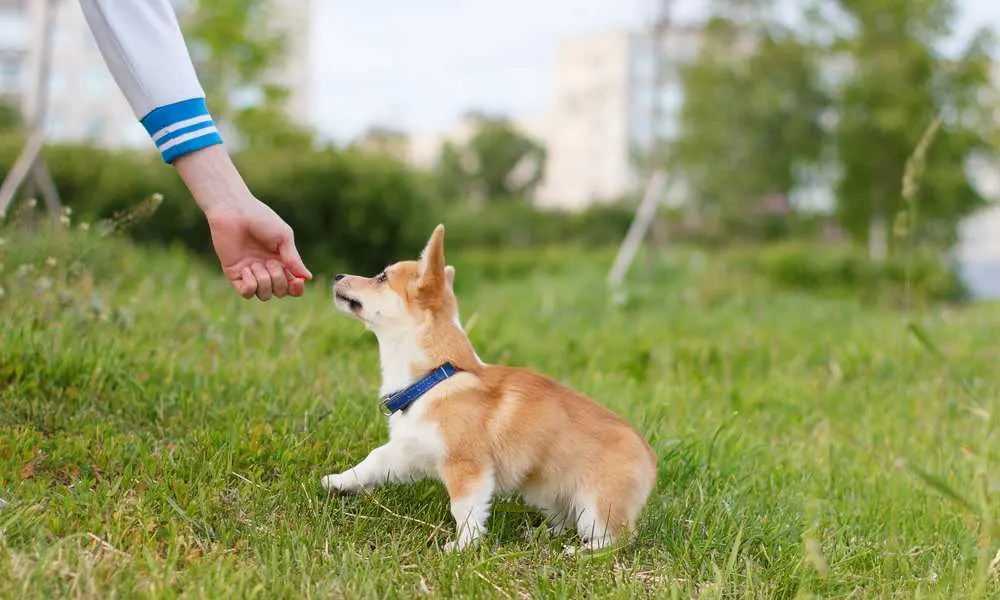
Try These 3 Methods To Train A Corgi To Come
There is more than one way for any command or trick in which you can teach it to your dog. Every breed is unique, and they react to commands differently. The fact with the corgi breed is that you need to be aware that they are very friendly and that it might take you more time to get them to listen.
Corgi dogs are very intelligent, but sometimes they find it hard to focus. Nevertheless, training your corgi to come is among the basic commands, and there are three methods in which you can achieve this:
- A method including a long leash
- A method called “at his level”
- A method called “the turn and run”
1. The first method is the one including a long leash.
- Put your corgi on a long leash. (It would be good for you to bring another person with you to keep your dog in one place while you do this)
- Take out a treat and show it to your corgi. Once he smells it, try talking in an exciting voice.
- Slowly walk away but hold the treat in your hand. Don’t go too far.
- Once you have your point, show the treat and say, “Come!”
- If he doesn’t respond the first time around, try repeating it again with a louder tone and squat down with the treat in your hand.
2. “At His Level” Method
- Put a collar on your corgi and clip a leash to it. (Also, it would be good to bring some company with you)
- Distance yourself from the dog, but at a point where he can see you clearly.
- Kneel down at his level, tap your hands to the ground and say, “come”. If he responds, praise him and pet him.
- As you succeed with this at a short distance, try doing this from farther away.
3. “Turn and Run Method”
- Start by choosing an item that your corgi will not be able to refuse, such as a toy or a treat he really likes.
- Bring this item to your corgi and let him smell it.
- After he sniffs it good, stand up and start slowly running with the item in your hand. As you begin to run, call your dog’s name and add “come”.
- Your dog should start running after you, and if he does so, the method works.
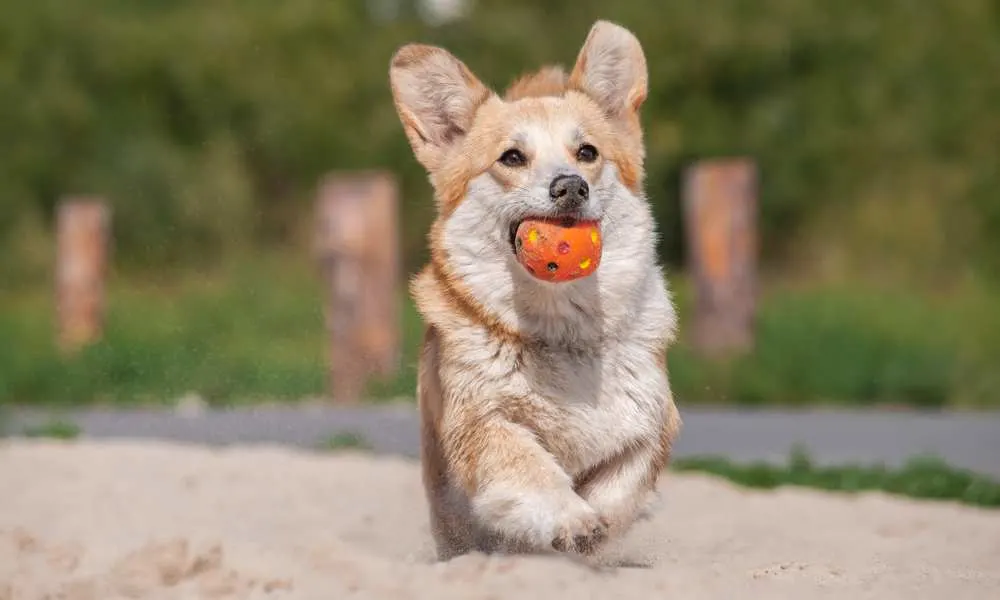
Some Additonal Tips
When training your corgi some basic commands like “come”, there are additional tips that can help you succeed in this quickly. They can be viewed as minor improvements to an already established method.
Here they are:
- Use high-value or treasured items as rewards for your corgi – when you are trying to teach your corgi to come, it would be best if you had some valuable items or favorite treats that will lure him even more.
- Begin by practicing this command indoors – teaching this command to your dog somewhere outdoors like the local park might not go as planned because of other external factors that will get in the way. Try practicing this command in your hallway or living room, perhaps.
- Don’t punish your dog for not obeying the first few times – as we mentioned before, different breeds react differently to commands. Maybe your corgi needs a bit more time than some other dog, and that is okay – be patient with him.
- Try saying “here” instead of “come” – saying “come” is not the only way this command works. You can also try saying “here” and clapping your hands. The important thing is that you should stick to the same command you started with. If you suddenly start saying “here” instead of “come”, your fog might get confused.
- Your corgi should come all the way – the training can be referred to as “successful” only if the dog comes all the way to you. Some dogs stop in the middle and wait for you to come to them. Keep calling them and showing the treats in your hand until they come and get it.

Books On Training
Many owners have undoubtedly thought about buying books on corgi training. Some people find it easier to follow specific written down rules when it comes to training their dog.
For example, you can try buying “A Dog Training Guide About Pembroke Welsh and Cardigan Welsh Corgi For Beginners.” Don’t be fooled by the common misconception that books are considered old-fashioned ways of training.
Today, there are more and more new writers who, through their own experiences, create a guide that is relatable to other corgi owners.
“A Dog Training Guide About Pembroke Welsh and Cardigan Welsh Corgi For Beginners” by Joseph Lint is a modern guide that will help you to efficiently and successfully train your corgi puppy into becoming the loyal pet you deserve.
We will try not to reveal much about this book, but what we can say is that, among else, it deals with:
- Necessary information, personality traits, characteristics, and possible bumps on the road you may come across while training
- Why corgi is the perfect addition to the family
- How to adequately prepare your interior space for a corgi puppy
- A detailed guide on command-specific tips
and many, many more!

Everything About Training A Corgi Puppy
Training your dog should start at an early age if you want to achieve the desired results. This means that after your corgi passes seven weeks of his life, you should get to work. Since you are dealing with not a fully-grown dog yet, it is recommended that you take baby steps.
Let’s focus on the 7, 8, and 10-week lifespan of your puppy.
What you should teach your corgi at seven weeks:
This should be considered as a starting point, and during this time, you should teach your corgi some basic daily routines that are not that complicated, such as:
- The location of his food and water bowl
- What and when is his eating schedule
- When is his bedtime
- When he will be taken out (once in the morning and once in the evening)
- At what grooming salon, he will get his trim, nails clipped, etc.
The key is to be consistent and have patience because they are young and still exploring the environment they live in now. Once you have established these basics, you can turn to:
- Teaching him to understand the meaning of “no” and “ah-ah.”
- Teaching him that “good dog” means he is behaving well
- Teaching him that when you open the crate dog, it is time to go inside
Sometimes, the owner rushes these training methods or teaches him the wrong manners. Don’t do that. It would be best if you were an excellent example to your puppy.
Let’s move on to when your corgi reaches eight weeks of life. Here is what follows:
- Teach your corgi to be calm indoors and behave well when there are guests
- Teach your corgi not to go crazy at the sound of the doorbell or a vacuum cleaner
- Teach your corgi not to take food and toys from you aggressively
- Teach your corgi not to jump or nibble on someone else’s arm or leg when outdoors
- Teach your corgi to stay still when you tell him to
Most importantly, during this phase, you should teach your corgi to start getting along with other pets in the house (if you have any). It is essential that they form a good relationship from the beginning.
Moving on, at ten weeks, your corgi should learn how to:
- Walk on the leash without pulling it too much
- Wait until you give them permission to walk inside
- TO COME EVERY TIME YOU CALL
- To be quiet in public places
After your corgi passes 12 weeks of life, he is no longer considered to be a little puppy. By now, he should have learned the basic commands and well-behavior.
The key to successful training is:
- ESTABLISHED LEADERSHIP
- BALANCE
- CONSISTENCY
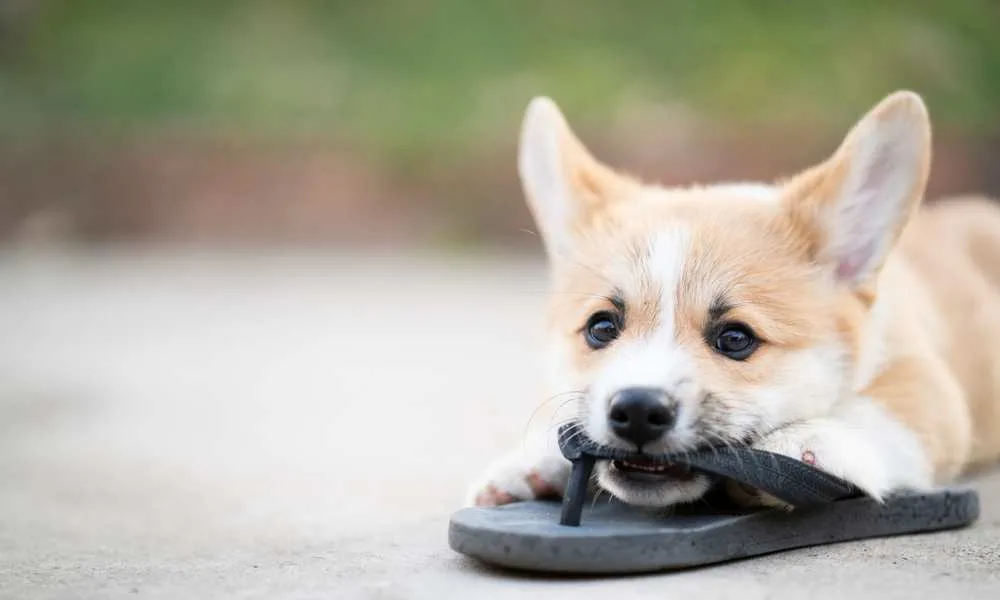
Behavioral Problems
No matter how hard you try to train your corgi, there still might be some behavioral problems because this is a stubborn breed. The incidents you should be aware of are:
- Breaking any items around the house
- Biting on the furniture
- Refusing to let go of your personal belongings
- Jumping on people who come to the house
- A constant need for attention
- Pulling when he is being walked on the leash
- Showing mild or severe signs of aggression
- Chasing and barking at other pets in the house
If you are having trouble with any of these incidents, you should teach your dog the meaning and significance of the command “NO. STOP THAT.” Although it is not recommended, if your corgi refuses to obey you after repeating this a few times, raise your voice a bit.
You might start asking yourself, why does he act this way? Here are a couple of plausible explanations for this challenging behavior.
- If you leave your corgi at home for more than 6 hours, he will start to panic, feel frustrated or develop “separation anxiety.” By the time you return, you might find your house in a mess.
- Suppose you don’t provide your corgi with sufficient daily exercises. In that case, they will destructively display this unused energy, and it can affect you, your other pets, people around you, or your personal belongings.
Read More: Why Does My Corgi Follow Me Everywhere?
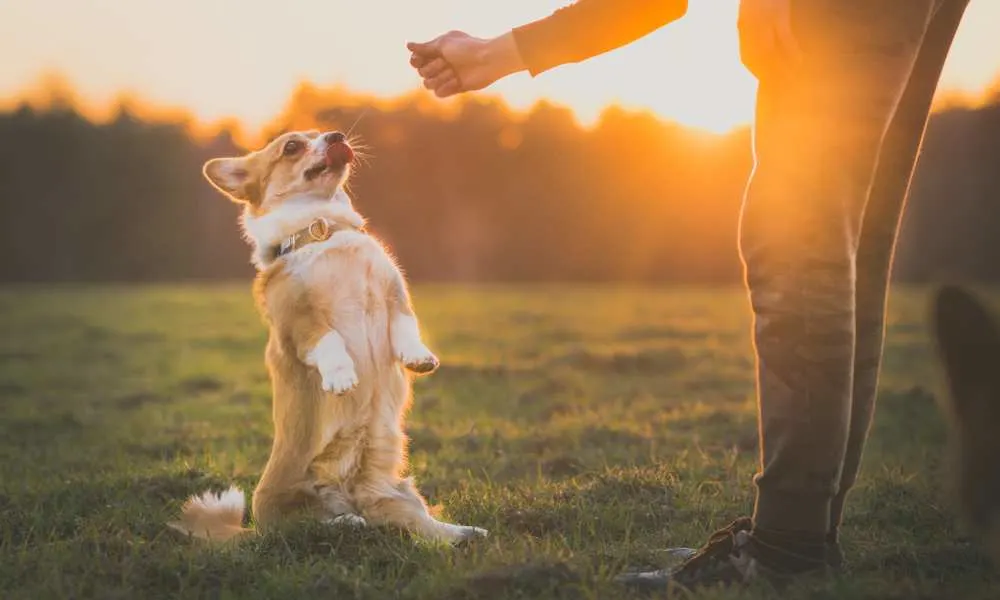
Fun Tricks
Besides the basic dog commands, you can teach your dog some cute and simple tricks. Once you have finished basic training, this will take only a small portion of your time.
Here are five simple tricks you can teach your corgi:
1. The Kiss
You can teach your corgi how to kiss you gently. For this, you will need some sticky tape, a clicker, and some treats to reward him.
2. Bark On Command
This is a very useful trick you can teach your dog. It can be extremely beneficial for when you are in public places. But have in mind, you will need a lot of patience. Learn More: How To Train A Corgi To Stop Barking?
3. Shake Hands
It is always fun to see a dog who can shake hands with his owner or someone else. The good thing is that your dog is accustomed to giving you his paw when he wants something, so teaching this will make it a lot easier.
4. Roll Over
Teaching this trick to your dog will take a bit more time, and you will need to repeat the command “roll over” more than a few times. You just need to be patient with your corgi.
5. Spin
Teaching your dog to spin is very hard to achieve, and you shouldn’t force this trick because your dog can get very dizzy. Be sure to give them water and food afterward.
Learn More: Are Corgis Trainable? How Long To Train A Corgi?
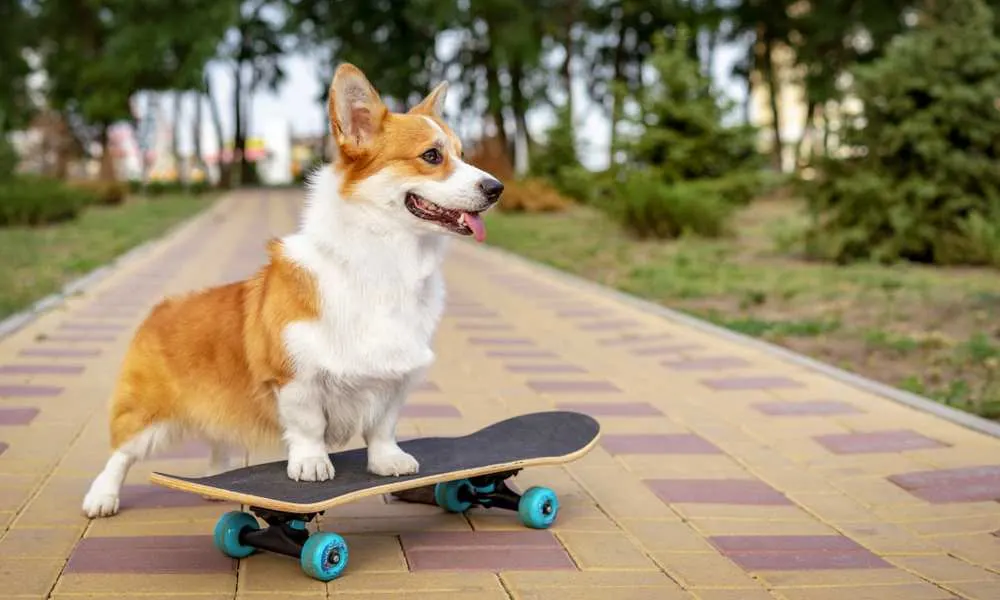
Fun Outdoor Activities
The corgi breed is incredibly friendly and always up for a new adventure. So, if you are looking for fun ways to keep your corgi fit and healthy, here are some outdoor activities you can enjoy together:
- A walk in the park – a casual walk in the park is the perfect way to spend a lovely afternoon, especially with your corgi. It is recommended that you spend between 1 and 2 hours walking.
- Hiking – if you are a more adventurous type, you can choose to go hiking on the weekend. Don’t worry about your corgi not having enough energy. He can walk between 6-8 miles on a daily basis without getting tired, but this hike shouldn’t be done in a rush.
- Jogging – for those who like to go on a morning jog, why not bring your corgi with you? Since this is not considered to be a fast run, your corgi should have no trouble keeping up.
- Sporting events – if your town is hosting some sporting events for pets, you shouldn’t miss them. They are an excellent way for your corgi to learn some new tricks maybe and get in shape.
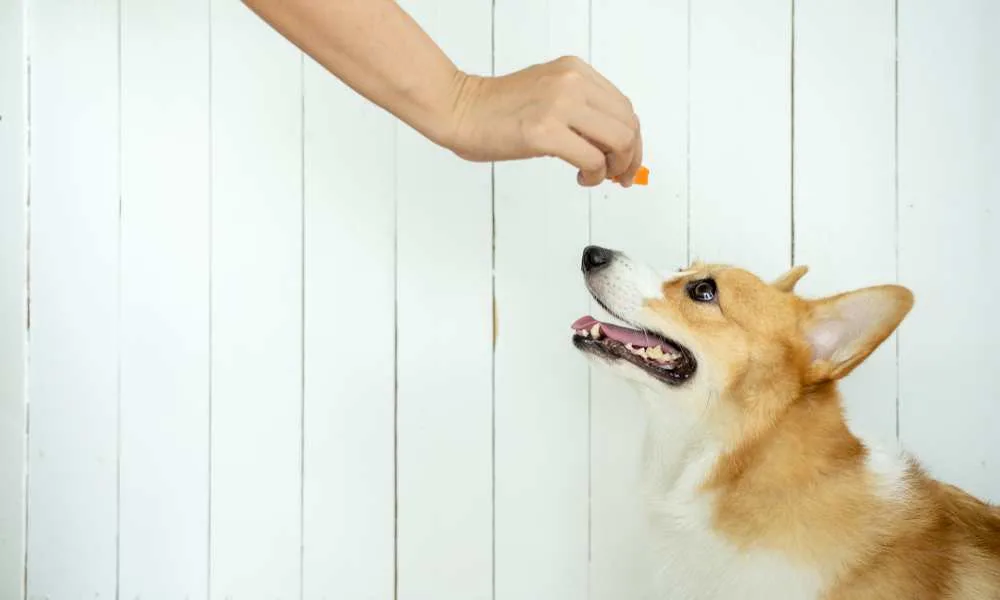
Conclusion
Training your corgi, some basic commands should be done before he is all grown-up. Efficient corgi training starts when your corgi passes seven weeks of his life. For example, during this period, your corgi should be trained to come after being called.
There are three methods in which you can train your corgi to come. They are: a method involving a leash, the “at his level” and the “turn and run” method. Each one should be done with patience.
After your corgi gets a little bit older, you can teach him some other things like not chewing on furniture, not biting people, behaving well in public places, staying still, and not showing signs of aggression. During the training process, you can use some treats, valuable items and start by practicing these indoors.
The corgi breed is known to be a bit stubborn, so during your training, you can come across some behavioral problems like breaking items around the house, refusing to let go of your personal belongings, jumping on people who come to the place, a constant need for attention, chasing and barking at other pets in the house, etc.
Some owners have turned to buying books on corgi training with a detailed guide on dealing with your pet if you are a beginner. Although some view this as an old-fashioned way of training, today, many modern guides provide relatable and well-explained training methods and approaches that will turn your corgi into a loyal pet.
Teaching your corgi some additional fun tricks is always a good idea. With a little effort, you can teach your corgi how to shake hands, spin, roll over, and many other tricks.
This breed loves adventures and will be more than happy to go on a walk, hike, jog with you.
See Also: Go Camping With Corgis – Are Corgis Good Camping Dogs?

